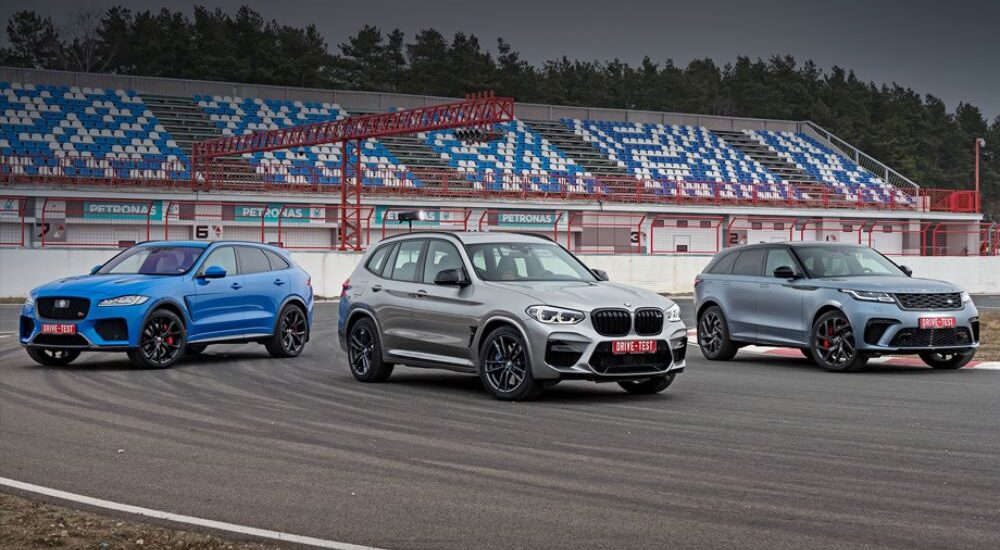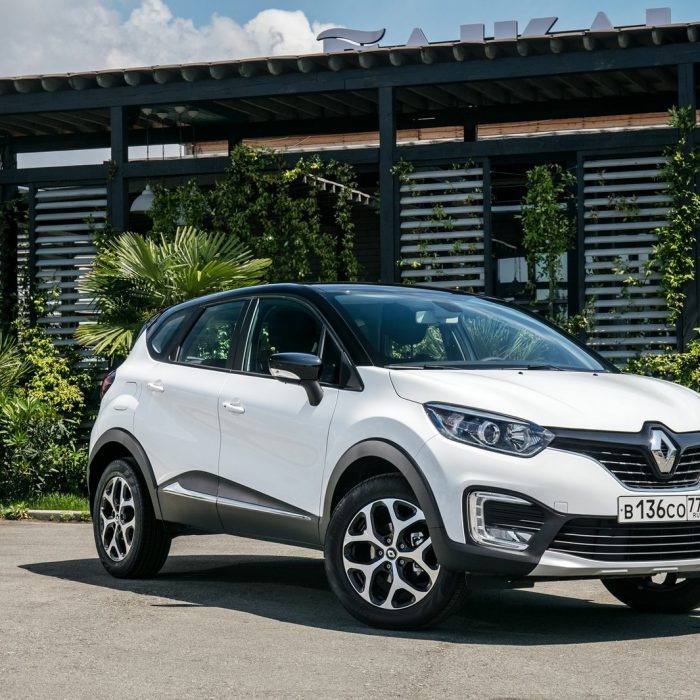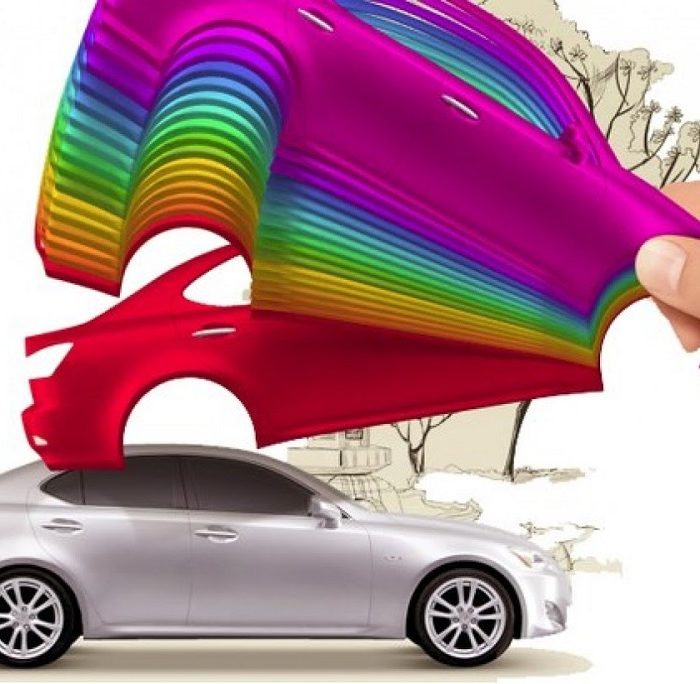I due crossover sportivi di questo test hanno gli stessi motori, nonostante alcune differenze di prezzo. Basate sulla stessa piattaforma, la Jaguar F-Pace SVR e la Range Rover Velar SVAutobiography Dynamic Edition utilizzano un V8 da cinque litri con compressore da 550 CV. All’epoca, la produzione avveniva nello stabilimento Ford di Bridgend, in Galles. Tuttavia, nell’autunno del 2020, il contratto per la fornitura di motori agli inglesi è scaduto e l’azienda è stata chiusa. Forse finisce l’era delle Jaguar e delle Range a otto cilindri “compressore”. I caldi “inglesi” possono passare ai sei cilindri a spinta. E la già nota BMW X3 M dimostra chiaramente che questa non è la fine del mondo.
La più leggera del trio, la BMW da 510 cavalli raggiunge i 100 km/h negli stessi 4,3 secondi della più potente SVR, con un handicap di quasi un centesimo. La Range Rover è altrettanto pesante della Jaguar e impiega quattro secondi e mezzo per accelerare. Così, le auto inglesi con un solo pilota e con pneumatici invernali sono in grado di confermare i dati del passaporto, e la X3 M non sembra ottenere un paio di decimi.
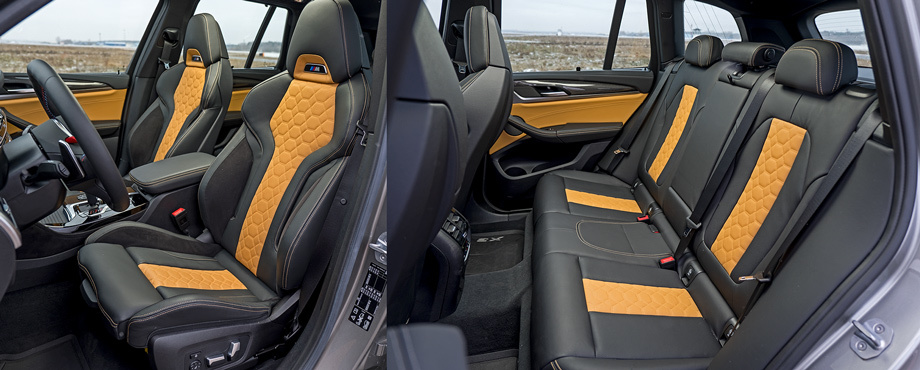
Ma non siamo severi. In primo luogo, le auto tedesche sono tradizionalmente sensibili ai pneumatici non standard: in questo caso, quelli invernali sono anche più stretti di quelli standard. In secondo luogo, ci sono così tante impostazioni di potenza che si possono combinare tutto il giorno. Ammetto che il programma sportivo che abbiamo scelto non è il più efficace. In un modo o nell’altro, i risultati delle misurazioni mostrano che in questo caso il numero di cilindri non influisce particolarmente sulla velocità.
Se si toglie il dispositivo di misurazione dal parabrezza e ci si affida alle sensazioni, la SVR sembra essere la più dinamica. In accelerazione, l’impressione è quella più forte. Quando si sale di giri, il V8 gorgoglia violentemente, quando si cambia marcia, grugnisce forte e quando si rilascia il gas, spara metallo dalla marmitta. L’ululato del compressore si nasconde dietro altri suoni. È la colonna sonora che dà all’accelerazione una leggera sfumatura di follia. C’è qualcosa di narcotico in questo, che costringe a premere sull’acceleratore anche quando non è particolarmente necessario. Sembra che l’entusiasmo reciproco del guidatore aggiunga forza alla Jaguar: è il primo a trascinarla. Se il passaggio ai sei cilindri è inevitabile, questo ringhio comincia già a mancarmi.
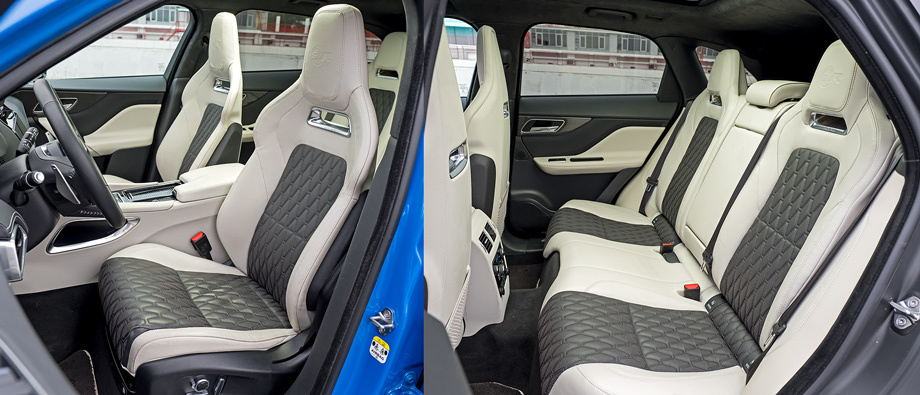
La Velar suona un po’ più modesta, ma anche piuttosto elegante. Soprattutto sullo sfondo della BMW, la cui emissione scialba sembra quasi sintetica. Tutti i sistemi di scarico sono dotati di valvole di bypass, che consentono di aggiungere drammaticità se necessario. Ma se la X3 M ricorda la posizione selezionata dell’ammortizzatore anche dopo un riavvio, allora SVR e SVA (mi permetto questa abbreviazione) passano a un tono più basso alla prima occasione. Ad esempio, quando si cambia la modalità di guida.
La differenza fondamentale tra le tre crossover sta nel fatto che nella “britannica” eccita il processo stesso di accelerazione, mentre nella BMW ne è il risultato: vedete, sul tachimetro ci sono già novanta miglia orarie! L’auto tedesca nasconde la velocità, mentre le avversarie sembrano metterla in evidenza. E rende la guida sulle strade pubbliche più interessante. E confortevole, soprattutto quando si tratta della SVA. Le sue sospensioni pneumatiche sono più rigide di quelle di una normale Velar, ma rispetto alla pizzicata M, la Range sembra essere un’auto assolutamente civile.

La Velar non è così sensibile ai piccoli difetti della strada, ignora completamente l’onda corta, anche se nota le irregolarità trasversali con fluttuazioni troppo evidenti delle masse non sospese. Ho paura di immaginare quanto pesino le ruote da 22 pollici… Anche in modalità sportiva, il telaio della Velar mantiene una morbidezza accettabile, tuttavia questo programma non si adatta bene alla natura imponente dell’auto.
La Jaguar non dispone di sospensioni pneumatiche e le molle più rigide rendono la SVR ancora più sconnessa di una normale F-Pace. In modalità dinamica, non c’è quasi mai una guida fluida. Tutto ciò che passa sotto le ruote fa rimbalzare l’auto. Il sistema multimediale permette di affinare le impostazioni: abbandonare l’eccessiva severità degli ammortizzatori, lasciando il motore, il cambio e l’amplificatore elettrico in “Sport”. Ma non toglierei nemmeno il volante dalla modalità Comfort: la precisione dei comandi non ne risente ed è più facile girare il volante.
Non sento una differenza fondamentale tra i programmi Sport e Sport Plus della M: entrambi sono estremamente scomodi. Come la Jaguar, la BMW rimbalza sulle asperità più piccole e il livello di accelerazione verticale aumenta così tanto che sembra che l’auto stia saltando. Ma basta cambiare Sport in Comfort e… beatitudine! La M è dura, ma non crudele. Un’altra cosa è la pista. In questo caso, utilizziamo il tracciato piatto e di recente costruzione di Myachkovo non come una pista da corsa, ma come un terreno di prova per la maneggevolezza al limite. In questo caso, la modalità sportiva costringe la X3 M a ricomporsi e ad affrontare le curve in modo da non farsi sorprendere.
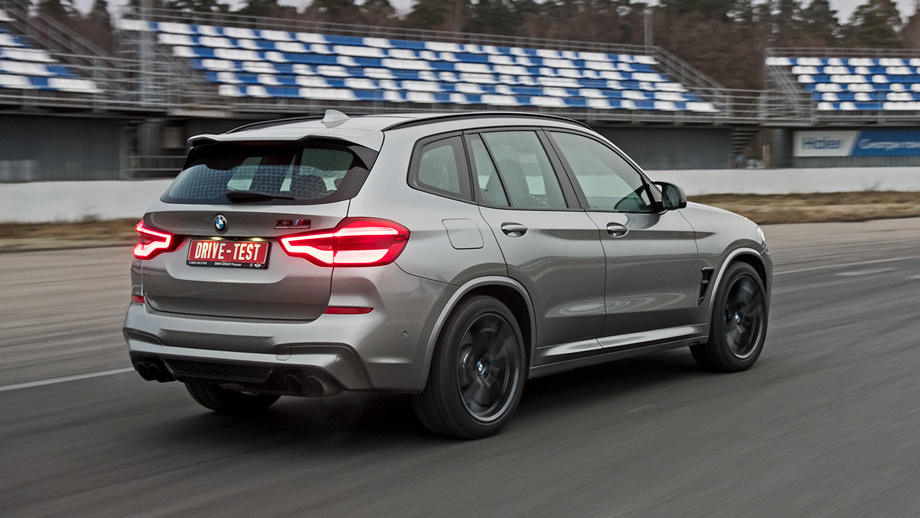
Sì, i rollio sono evidenti, ma non interferiscono troppo con la guida attiva. Certo, la BMW tira fuori il muso dalla curva troppo presto e, al rilascio del gas, sbanda un po’ troppo presto. Tuttavia, questi processi si sviluppano gradualmente, lasciando il tempo per una valutazione e una correzione accurate. Anche in questo caso, è meglio liberare l’amplificatore elettrico dall’eccessiva viscosità della modalità sportiva. Il volante, leggero e moderatamente affilato (2,2 giri da bloccaggio a bloccaggio), con una corona rigonfia, offre un feedback affidabile e una netta variazione dello sforzo a seconda dell’angolo e del carico.
E questo nonostante il fatto che il telaio operi in una modalità anomala: invece di pneumatici di larghezza diversa 255/40 R21 davanti e 265/40 R21 dietro, sulla nostra auto sono installati 255/45 R20 “in cerchio”. Inoltre, il modello Pirelli Scorpion Winter friction di per sé non spicca sull’asfalto asciutto e freddo. Ma è più facile godersi gli slittamenti di potenza con la modalità 4WD Sport. La distribuzione della trazione dà la priorità all’asse posteriore, dove il differenziale M con bloccaggio a controllo elettronico lavora con forza e potenza. Spettacolare! Ed è più facile gestire la sbandata rispetto a tutti i concorrenti.
Le “inglesi”, anch’esse dotate di differenziali intelligenti, non hanno un programma di trasmissione così frivolo e, nonostante la trazione da rottamare, entrambe sono restie a derapare sotto il gas. Almeno, su strada asciutta. Per essere sicuri, è meglio pre-scaricare l’asse posteriore rilasciando brevemente l’acceleratore. La Jaguar è piuttosto scattante: basta avere il tempo di prenderla. Gas! Le ruote anteriori si alzano, ma lo slittamento non si sviluppa sempre in modo prevedibile, come se la trazione integrale fosse stata disposta con un autobloccante interasse. Il momento cammina lungo gli assi, rendendo difficile mantenere un angolo costante.

Il rapporto di trasmissione dei meccanismi di sterzo dei crossover britannici è lo stesso. Il volante compie poco più di due giri e mezzo tra le posizioni estreme. Gli amplificatori sono configurati in modo diverso. Il volante Jaguar resiste più attivamente, ma il feedback è più pulito. È più facile ruotare quello della Velar, anche se la guida manca già un po’ di trasparenza. Inoltre, la Velar non si tuffa in curva, come la Jaguar: all’inizio rotola, e quando un attimo dopo si trasforma in un arco, può richiedere una correzione.
In linea di massima, in termini di movimento della traiettoria al limite della tenuta, entrambe le “parenti” sembrano essere più grasse rispetto alla BMW. Oltre ai rollio trasversali, anche quelli longitudinali sono fastidiosi, sia in accelerazione che in decelerazione. Per una Velar morbida, i beccheggi e i tentativi di retrocedere a tutto gas sono organici. Sorprendentemente, anche la dura F-Pace non è molto meglio. Jeep è Jeep. I pesanti V8 non sono chiaramente il modo migliore per influenzare la distribuzione dei pesi. Il comportamento delle auto dipende in larga misura dalla ridistribuzione dinamica della massa e, quando si itera con la velocità all’ingresso della curva, di norma le auto si dirigono verso il cordolo esterno.
Per percepire meglio la differenza tra i caratteri dei due co-piattaforma, è necessario abbassare il livello a una corsa dinamica in città. Qui abbiamo due individui distinti. La Velar, in linea di massima, rimane una specie di camion con un volante senza vita e sospensioni imponenti. Guida morbida, sedili ampi, scarico ovattato per non disturbare il silenzio nell’abitacolo. La SVR, al contrario, acquista una forma sportiva. Nella metropoli, è una sorta di XKR a cinque porte. Furiosa, risponde con decisione al volante e all’alimentazione, mantenendo il guidatore in buona forma. Non si aggrappa nemmeno all’asfalto ed è pronta a girare come una trottola a un certo interscambio, soprattutto se si maneggia il gas con noncuranza.

I pneumatici invernali degli “inglesi” sono abbinati per dimensione. La Jaguar monta gli stessi Pirelli della X3 M, la Velar i Continental ContiCrossContact Winter. Ed è la pesante Range a dimostrare la decelerazione più efficace. Il risultato migliore è di 129,9 piedi quando si frena da 60 mph. La Jaguar si ferma a 3,2 piedi in più. La distanza di arresto più breve per una BMW è di 7,8 piedi più lunga di quella della Velar. Tirando una qualsiasi delle tre auto, si nota una notevole corsa del pedale. Ma solo per la M questa impostazione civile sembra innaturale.
Per quanto riguarda l’isolamento acustico, non è male in tutti e tre i crossover. Ovunque la principale dominante acustica è il suono del motore. O dello scarico, se gli smorzatori nelle marmitte sono aperti. Con l’aumento della velocità nelle auto inglesi, il vento inizia a soffiare prima. Anche in una BMW la visibilità anteriore è rovinata dai massicci montanti A, e nella Jaguar e nella Range questo problema è aggravato da tergicristalli poco efficienti che lasciano un’ampia striscia non pulita vicino al montante sinistro.
Tuttavia, le dimensioni si sentono meglio nella Range, grazie alla posizione di seduta alta. I sedili non differiscono da quelli che vengono montati su modifiche più semplici – e, stranamente, sono i più comodi del test, sono più facili da personalizzare per sé, hanno meno domande. Vista da dietro il volante, la Velar assomiglia a un imponente SUV, che rende la compatta Range Rover affine agli adulti. Anche nella posizione più bassa del sedile, il cofano è chiaramente visibile. Dal punto di vista ergonomico, però, questa è l’auto più difficile a causa dell’abbondanza di pannelli a sfioramento.

La M sembra un’autovettura e il controllo delle funzioni ausiliarie è intuitivo. La Jaguar è una via di mezzo: ha più tasti fisici della Velar. Ma il riscaldamento dei sedili è ancora nascosto nella giungla della multimedialità, che non si avvia così rapidamente come vorremmo. I sedili rigidi, simili a secchielli, promettono solo una vestibilità sportiva, ma in realtà ci si siede sensibilmente più in alto rispetto alla BMW.
In fuoristrada, la Velar è prevedibilmente la più abile. Le sospensioni pneumatiche con regolazione dell’altezza di marcia offrono una migliore capacità geometrica in fuoristrada. L’articolazione degli assali è buona e il sistema proprietario Terrain Response 2 consente di gestire efficacemente la trazione. Non siamo andati in profondità, ma più dovevamo salire, più la Range Rover sarebbe apparsa redditizia.
E più evidente sarebbe la differenza tra essa e la Jaguar: La SVR è priva delle modalità speciali off-road e della possibilità di modificare l’irrisoria altezza da terra. La carrozzeria della M è più alta e, finché la geometria BMW lo consente, gestisce la strada altrettanto bene della Range grazie alle prestazioni esemplari del controllo di trazione, che imita abilmente il bloccaggio.
Fortunatamente, tra i partecipanti al test non c’è una sola auto che richieda un freddo calcolo. Tutte e tre le auto sono irrazionali, anche se la BMW lo è meno. La M esternamente è la modestia stessa secondo gli standard del segmento. Solo i grandi freni suggeriscono in qualche modo ai corridori del semaforo che è meglio non competere con questa “X”. Ma nella società di oggi, l’eccellenza tecnica non aggiunge punti alla M. È più efficiente in condizioni estreme, più veloce su un percorso tortuoso e, forse, più comoda nella vita di tutti i giorni – ma più noiosa di qualsiasi “britannica”. Per questi soldi, vorrei sorridere più spesso.
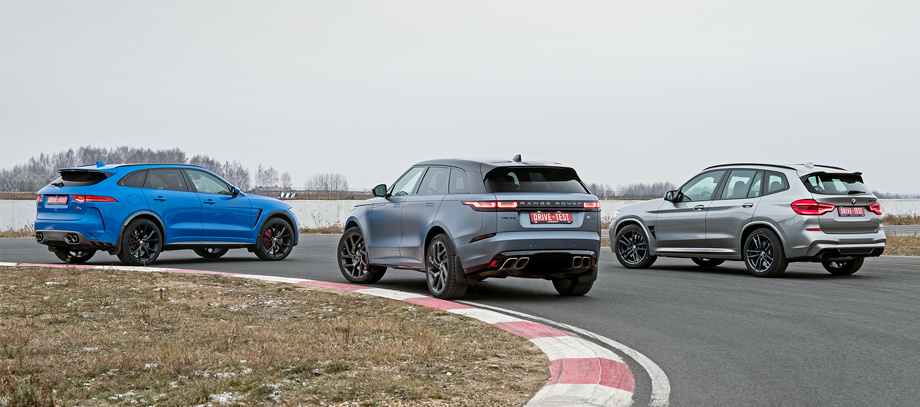
La rumorosa SVR è l’altro estremo. Con un gran rumore, si colloca dietro la BMW. E gli interni non valgono assolutamente i soldi richiesti dalla Jaguar. La Velar con motore V8 non è così rumorosa ed è più facile da immaginare come pendolare quotidiano rispetto alla SVR. Allo stesso tempo, è più emozionale della BMW, un’opzione crossover sportiva più americana. Si adatta meglio alla vita su larga scala rispetto alla precisa e un po’ fredda X3 M. Naturalmente, questa è soprattutto la Velar con tutta una serie di decisioni discutibili. Ma inizialmente stiamo parlando della scelta del cuore.
Tutti i nostri carismatici sono eccentrici, e tra questi la Range Rover sembra essere la più versatile. Dirò di più: è il “compressore” Velar l’unico degno di attenzione nella linea di modelli. È chiaro che le sue capacità di cross-country rimarranno inespresse, perché è necessario arrampicarsi da qualche parte, sporcarsi. Ma il piacere del design e del motore stravagante non richiede assolutamente alcuno sforzo. In breve: questa volta si può tranquillamente acquistare l’auto più costosa.
Questa è una traduzione. Potete leggere l’originale qui: https://www.drive.ru/test-drive/bmw/5de911a4ec05c4a07900000f.html

Pubblicato Aprile 27, 2023 • 11m da leggere

